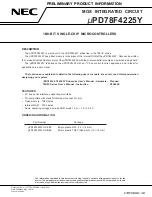
MOTOROLA
Chapter 27. SCC BISYNC Mode
27-3
Part V. The Communications Processor Module
interrupt is issued according to TxBD[I]. TxBD[I] controls whether interrupts are generated
after transmission of each buffer, a speciÞc buffer, or each block. The controller then
proceeds to the next BD.
If no additional buffers have been sent to the controller for transmission, an in-frame
underrun is detected and the controller starts sending syncs or idles. If the controller is in
transparent mode, it sends DLE-sync pairs. Characters are included in the block check
sequence (BCS) calculation on a per-buffer basis. Each buffer can be programmed
independently to be included or excluded from the BCS calculation; thus, excluded
characters must reside in a separate buffer. The controller can reset the BCS generator
before sending a speciÞc buffer. In transparent mode, the controller inserts a DLE before
sending a DLE character, so that only one DLE is used in the calculation.
27.3 SCC BISYNC Channel Frame Reception
Although the receiver is designed to work with almost no core intervention, the user can
intervene on a per-byte basis if necessary. The receiver performs CRC16, longitudinal
(LRC) or vertical redundancy (VRC) checking, sync stripping in normal mode, DLE-sync
stripping, stripping of the Þrst DLE in DLE-DLE pairs in transparent mode, and control
character recognition. Control characters are discussed in Section 27.6, ÒSCC BISYNC
Control Character Recognition.Ó
When enabled, the receiver enters hunt mode where the data is shifted into the receiver shift
register one bit at a time and the contents of the shift register are compared to the contents
of DSR[SYN1, SYN2]. If the two are unequal, the next bit is shifted in and the comparison
is repeated. When registers match, hunt mode is terminated and character assembly begins.
The controller is character-synchronized and performs SYNC stripping and message
reception. It reverts to hunt mode when it receives an
ENTER
HUNT
MODE
command, an error
condition, or an appropriate control character.
When receiving data, the controller updates the BCS bit in the BD for each byte transferred.
When the buffer is full, the controller clears the E bit in the BD and generates an interrupt
if the I bit in the BD is set. If incoming data exceeds the buffer length, the controller fetches
the next BD; if E is zero, reception continues to its buffer.
When a BCS is received, it is checked and written to the buffer. The BISYNC controller
sets the last bit, writes the message status bits into the BD, clears the E bit, and then
generates a maskable interrupt, indicating that a block of data was received and is in
memory. The BCS calculations do not include SYNCs (in nontransparent mode) or
DLE-SYNC pairs (in transparent mode).
Note that GSMR_H[RFW] should be set for an 8-bit-wide receive FIFO for the BISYNC
receiver. See Section 22.1.1, ÒGeneral SCC Mode Register (GSMR).Ó
Summary of Contents for MPC860 PowerQUICC
Page 3: ...MPC860UM AD 07 98 REV 1 MPC860 PowerQUICC ª UserÕs Manual ...
Page 36: ...xxxvi MPC860 PowerQUICC UserÕs Manual MOTOROLA CONTENTS Paragraph Number Title Page Number ...
Page 78: ...I iv MPC860 PowerQUICC UserÕs Manual MOTOROLA Part I Overview ...
Page 88: ...1 10 MPC860 PowerQUICC UserÕs Manual MOTOROLA Part I Overview ...
Page 114: ...3 16 MPC860 PowerQUICC UserÕs Manual MOTOROLA Part I Overview ...
Page 226: ...8 32 MPC860 PowerQUICC UserÕs Manual MOTOROLA Part II PowerPC Microprocessor Module ...
Page 262: ...9 36 MPC860 PowerQUICC UserÕs Manual MOTOROLA Part II PowerPC Microprocessor Module ...
Page 274: ...III iv MPC860 PowerQUICC UserÕs Manual MOTOROLA Part III Configuration ...
Page 320: ...12 12 MPC860 PowerQUICC UserÕs Manual MOTOROLA Part III Configuration ...
Page 325: ...MOTOROLA Part IV Hardware Interface IV v Part IV Hardware Interface ...
Page 326: ...IV vi MPC860 PowerQUICC UserÕs Manual MOTOROLA Part IV Hardware Interface ...
Page 352: ...13 26 MPC860 PowerQUICC UserÕs Manual MOTOROLA Part IV Hardware Interface ...
Page 394: ...14 42 MPC860 PowerQUICC UserÕs Manual MOTOROLA Part IV Hardware Interface ...
Page 426: ...15 32 MPC860 PowerQUICC UserÕs Manual MOTOROLA Part IV Hardware Interface ...
Page 530: ...17 26 MPC860 PowerQUICC UserÕs Manual MOTOROLA Part IV Hardware Interface ...
Page 632: ...21 44 MPC860 PowerQUICC UserÕs Manual MOTOROLA Part V The Communications Processor Module ...
Page 660: ...22 28 MPC860 PowerQUICC UserÕs Manual MOTOROLA Part V The Communications Processor Module ...
Page 708: ...24 24 MPC860 PowerQUICC UserÕs Manual MOTOROLA Part V The Communications Processor Module ...
Page 748: ...27 20 MPC860 PowerQUICC UserÕs Manual MOTOROLA Part V The Communications Processor Module ...
Page 846: ...31 20 MPC860 PowerQUICC UserÕs Manual MOTOROLA Part V The Communications Processor Module ...
Page 914: ...35 12 MPC860 PowerQUICC UserÕs Manual MOTOROLA Part V The Communications Processor Module ...
Page 948: ...36 34 MPC860 PowerQUICC UserÕs Manual MOTOROLA Part V The Communications Processor Module ...
Page 998: ...37 48 MPC860 PowerQUICC UserÕs Manual MOTOROLA Part VI Debug and Test ...
Page 1016: ...A 10 MPC860 PowerQUICC UserÕs Manual MOTOROLA Appendixes ...
Page 1024: ...B 8 MPC860 PowerQUICC UserÕs Manual MOTOROLA Appendixes ...
Page 1030: ...C 6 MPC860 PowerQUICC UserÕs Manual MOTOROLA Appendixes ...
Page 1086: ...Glossary 12 MPC860 PowerQUICC UserÕs Manual MOTOROLA ...
Page 1106: ......
















































